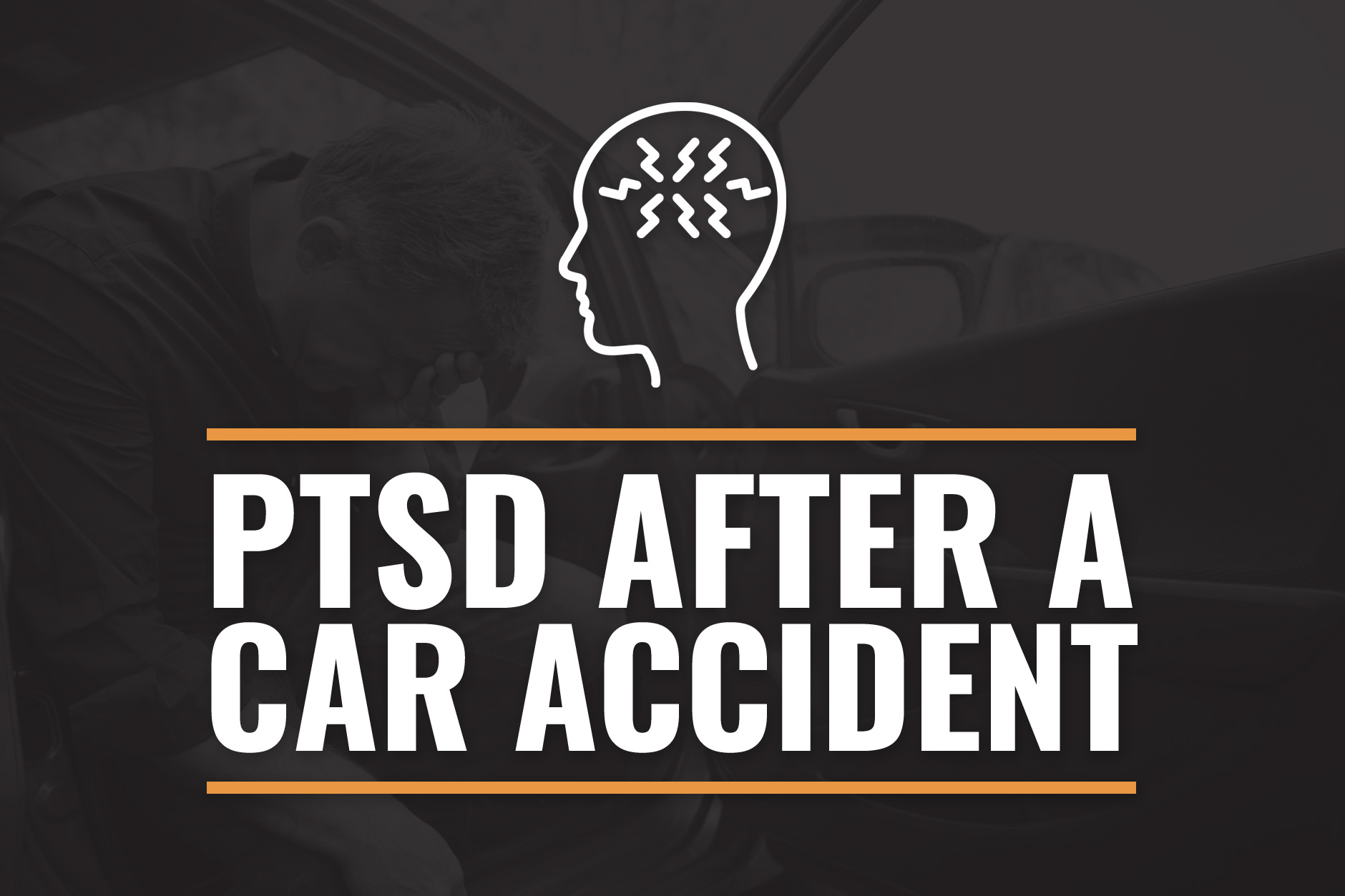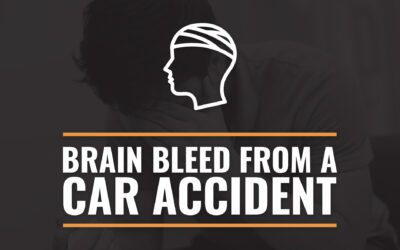
Table of Contents
\A car accident happens in a matter of seconds, but the psychological impact can last for months or even years. While broken bones heal and bruises fade over time, the invisible scars left by a traumatic collision tend to be more persistent. If you’ve been avoiding certain routes, experiencing flashbacks, or feeling on edge since your accident, you might be dealing with post-traumatic stress disorder.
Car accidents are the leading cause of PTSD among civilians in the United States, affecting as many as 2.5 to 7 million Americans. Studies show that about 25-33% of car accident survivors develop this condition within the first 30 days after a collision. While these are statistics, they also represent real people whose lives have been disrupted by an experience they can’t seem to shake. In this guide, we’ll explain the signs of PTSD after a car accident, recommended treatment, and how a car accident lawyer can help.
What PTSD Really Means After a Car Crash
Post-traumatic stress disorder is a mental health condition that develops after you experience or witness a terrifying event. When your brain encounters a life-threatening situation like a serious car accident, it goes into survival mode. For most people, the stress and fear subside as time passes. But for some, the brain gets stuck in that high-alert state, continuing to react as though the danger hasn’t passed.
PTSD isn’t a weakness, and it isn’t something you can simply “get over” by thinking positively. Recent advances in neuroimaging have revealed that PTSD causes actual physical changes in the brain. The hippocampus, which plays a key role in memory formation, can shrink in people with PTSD. The amygdala, which processes fear and emotions, can become overactive. These real injuries to the brain need proper treatment, just like any physical injury from your accident.
You can develop PTSD even if you weren’t seriously injured. What matters more is how you perceived the threat during the accident. If you felt intense fear or helplessness during the collision, your risk increases. Witnessing serious injuries or fatalities arising from the wreck also raises your chances of developing PTSD.
What are the Warning Signs of PTSD?
Many accident survivors don’t realize they’re experiencing PTSD because the symptoms can seem unrelated to the crash. You might think you’re just stressed or having a hard time adjusting. But if these feelings persist for more than a month and interfere with your daily life, you could be dealing with something more serious.
Reliving the Accident
One of the most common signs of PTSD is repeatedly reliving the crash in your mind. You might experience vivid flashbacks that make you feel like you’re right back at the scene of the accident. The sound of screeching tires or the smell of burning rubber can instantly transport you back to that moment. These intrusive thoughts can pop up at any time, making it hard to concentrate at work or enjoy time with family.
Flashbacks aren’t always triggered by obvious reminders. Sometimes they happen seemingly out of nowhere. You might be sitting at your desk when suddenly you’re back in that moment of impact, feeling the same terror you felt during the actual accident. These episodes can be so vivid that your body reacts as though the danger is happening right now, causing your heart to race and your hands to shake.
Avoidance Behaviors
Avoidance might seem like a good coping strategy at first. You might take a longer route to work to bypass the location where your accident happened. You might refuse to drive at all, relying on others for transportation. Some people avoid talking about the accident entirely, changing the subject whenever it comes up in conversation.
The problem with avoidance is that it only makes the fear grow stronger. When you avoid the things that remind you of the trauma, you never give your brain a chance to learn that these situations are actually safe. The anxiety builds, and soon you might find yourself avoiding more and more things. This can seriously limit your life, affecting your ability to work, maintain relationships, and participate in activities you once enjoyed.
Hyperarousal and Constant Alertness
After a traumatic accident, your nervous system can get stuck in fight-or-flight mode. You might feel constantly tense, as though danger is always lurking around the corner. This hypervigilance can make you jumpy and easily startled. A car backfiring on the street might send you into a panic, or you might have trouble sleeping because your body refuses to relax enough to rest.
This constant state of alertness affects more than your mood. For example:
- You might snap at your spouse over small things that wouldn’t have bothered you before.
- Your patience with your kids can run thin.
- Coworkers might notice you’re more irritable than usual.
- You feel angry without a clear reason, and the anger can explode over minor frustrations.
Your body is exhausted from being on high alert all the time, but your mind won’t let you calm down. Over time, your physical and mental health can suffer.
Changes in Mood and Thinking
PTSD can alter how you think and feel about yourself and the world around you. You might develop a persistent sense of hopelessness, feeling like things will never get better. Some people experience survivor’s guilt, especially if others were seriously injured or killed in the accident. You might blame yourself for the crash, replaying every decision you made that day and torturing yourself with “what if” scenarios.
Emotional numbness is another common symptom that catches people off guard. You might feel disconnected from the people you love, unable to experience joy or affection. Activities that once brought you happiness now seem pointless. This emotional flatness can strain your relationships, as family and friends struggle to understand why you’ve become so distant and withdrawn.
Memory problems can also emerge. You might have trouble remembering important details about your life before the accident. Some people find their minds going blank during conversations or forgetting appointments and commitments. These cognitive issues stem from the way trauma affects the brain’s ability to process and store information normally.
The Physical Toll of Psychological Trauma
PTSD doesn’t only affect your mental state. It can cause real physical symptoms that impact your daily functioning. Your body stays in a heightened stress state, triggering a cascade of physical reactions that can be as debilitating as the psychological symptoms. They include:
- Chronic Headaches and Migraines: Many people with PTSD report persistent headaches that don’t respond well to over-the-counter pain medication. The constant tension and stress your body holds can trigger tension headaches or full-blown migraines that interfere with work and daily activities.
- Gastrointestinal Problems: Your gut is directly connected to your nervous system, and trauma affects both. You might experience stomach pain, nausea, diarrhea, constipation, or irritable bowel symptoms. These digestive issues stem from the way your body processes stress hormones.
- Muscle Tension and Body Aches: Your muscles stay contracted when you’re in a constant state of hypervigilance. This tension can cause pain in your neck, shoulders, back, and jaw. You might clench your teeth without realizing it, leading to jaw pain and headaches.
- Sleep Disturbances: You might have trouble falling asleep because your mind races with thoughts about the accident. When you do sleep, nightmares might wake you up repeatedly throughout the night. This lack of quality sleep compounds other PTSD symptoms, making it harder to regulate emotions, think clearly, and cope with stress during the day.
- Cardiovascular Symptoms: Some people experience rapid heartbeat, chest pain, or palpitations when triggered by reminders of the accident. Your heart rate might spike unexpectedly, making you feel like you’re having a heart attack when you’re actually experiencing a trauma response.
- Fatigue and Exhaustion: Being in a constant state of alert drains your energy reserves. You might feel exhausted even after a full night’s sleep because your body never truly rests. This fatigue affects your ability to concentrate, make decisions, and handle daily responsibilities.
- Somatic Symptoms Mimicking Accident Injuries: Some people develop physical symptoms that mimic the injuries they sustained during the accident, even after those injuries have healed. This isn’t imaginary pain. Your brain’s trauma response can actually cause real physical sensations as it continues to react to the perceived threat. These somatic symptoms can include chest pain, shortness of breath, dizziness, and trembling.
These physical symptoms aren’t separate from your PTSD. They’re part of how your body responds to unresolved trauma. When you seek treatment for PTSD, addressing these physical manifestations becomes part of your recovery plan. Many people find that as their psychological symptoms improve through therapy, their physical symptoms also decrease.
When Symptoms Turn Into Unhealthy Coping
As PTSD symptoms intensify, many people turn to unhealthy coping mechanisms without realizing it. You might start drinking more to help you relax or fall asleep. Some people use substances to numb the emotional pain or quiet the intrusive thoughts. Excessive spending, risky behaviors, or withdrawing completely from social activities can all be warning signs that PTSD is taking a deeper toll than you realize.
These coping strategies provide temporary relief but make the underlying problem worse. Alcohol might help you sleep initially, but it disrupts your sleep cycle and can intensify depression and anxiety. Using substances to manage symptoms prevents you from developing healthy coping skills and can lead to dependence. The isolation that comes from withdrawing from friends and family removes the support system you need most during recovery.
How PTSD Gets Diagnosed
Getting a proper diagnosis is the first step toward recovery. A mental health professional will conduct a comprehensive evaluation, usually lasting 45 to 60 minutes. This assessment includes detailed discussions about your accident and the symptoms you’ve been experiencing. Your clinician will likely ask you to complete questionnaires designed to gauge the severity of your symptoms.
To receive a PTSD diagnosis, you must meet specific criteria outlined in the Diagnostic and Statistical Manual of Mental Disorders. These criteria include exposure to actual or threatened death or serious injury, along with symptoms from four categories. You need at least one intrusion symptom, one avoidance symptom, two negative changes in thoughts and mood, and two arousal and reactivity symptoms. These symptoms must last for more than one month and cause substantial distress or impairment in your daily life.
Some people develop what clinicians call subsyndromal or partial PTSD. These individuals experience high levels of hyperarousal and re-experiencing symptoms but don’t have as many avoidance or numbing symptoms. The prognosis for partial PTSD tends to be somewhat better, with many people seeing symptom remission within six months. However, any level of post-traumatic stress requires medical attention.
Treatment Options That Actually Work
PTSD is highly treatable, and many people who receive proper care are able to return to their normal routines. The key is getting help early. The sooner you start treatment after your accident, the better your chances of a full recovery. Several evidence-based treatments have proven effective for car accident survivors.
Cognitive Behavioral Therapy
Cognitive behavioral therapy has become one of the most effective treatments for PTSD following motor vehicle accidents. This type of therapy helps you identify and change the negative thought patterns that developed after your trauma. You’ll work with your therapist to examine beliefs like “I’m not safe anywhere” or “It’s only a matter of time before another accident happens.” These distorted thoughts keep you trapped in fear and anxiety.
CBT teaches you practical skills for managing your symptoms. You’ll learn how to recognize when your thinking has become distorted and how to challenge those thoughts with evidence from reality. You’ll also develop coping strategies for handling triggers and reducing anxiety. Most people complete CBT within 12 to 16 sessions, though the timeline varies based on individual needs.
Exposure Therapy
Exposure therapy is specifically designed to help you confront the situations and memories you’ve been avoiding. This might sound terrifying at first, but it’s done gradually and safely under the guidance of a trained therapist. You might start by talking about the accident in detail, allowing yourself to experience the emotions that come up. As you become more comfortable, you might work up to sitting in a parked car, then riding as a passenger, and eventually driving again.
The goal of exposure therapy isn’t to force you into uncomfortable situations. Instead, it’s designed to help your brain relearn that these situations aren’t actually dangerous. When you face your fears in a controlled, supportive environment and nothing bad happens, your brain starts to rewire its fear response. Over time, the things that once triggered panic attacks become manageable again.
EMDR Therapy
Eye Movement Desensitization and Reprocessing, commonly known as EMDR, has shown remarkable results in treating PTSD. This therapy involves recalling your traumatic memories while performing bilateral stimulation, usually through guided eye movements or hand tapping. The technique helps your brain process the traumatic memories differently, reducing their emotional intensity.
During EMDR sessions, you’ll work with your therapist to identify specific trauma targets for processing. You’ll also learn resourcing techniques that help you feel safe and grounded at work. Many people find that EMDR helps transform the way traumatic memories are stored in the brain, freeing them from flashbacks and nightmares. The therapy can work relatively quickly compared to traditional talk therapy, with many people experiencing relief within a few months.
Medication Management
While therapy addresses the root causes of PTSD, medication can help manage symptoms while you’re doing that work. Antidepressants, particularly selective serotonin reuptake inhibitors like sertraline and paroxetine, are commonly prescribed for PTSD. These medications can help reduce depression, anxiety, and intrusive thoughts. They work by adjusting the balance of neurotransmitters in your brain that affect mood and fear responses.
Anti-anxiety medications may be prescribed for short-term use to help you through particularly difficult periods. Some doctors prescribe prazosin to help reduce nightmares and improve sleep quality. Medication isn’t a cure for PTSD on its own, but it can make it easier for you to engage in therapy and develop coping skills. Your doctor will work with you to find the right combination and dosage for your specific symptoms.
Your Rights Under Michigan Law
If you’re dealing with PTSD after a car accident in Michigan, you have legal rights that can help you access the treatment you need. Michigan’s no-fault insurance law requires auto insurance policies to include Personal Injury Protection (PIP) benefits. They should cover your medical expenses related to the accident, including mental health treatment.
To access them, you need to file an application for no-fault benefits with your insurance company within one year of the accident. Mental health treatment, including therapy and psychiatric care, qualifies as a reasonably necessary medical expense under Michigan law. If your doctor or mental health professional relates your PTSD to the car accident, your insurance company should approve coverage for your treatment.
Many people don’t realize that free counseling might be available to them through their auto insurance. Your no-fault insurance can cover the full cost of therapy sessions, psychiatric appointments, and prescribed medications for PTSD, so request approval for mental health treatment as part of your post-accident recovery plan.
Make sure you document your symptoms from the beginning. Keep detailed medical records showing the connection between your accident and your mental health symptoms: this documentation becomes critical if your insurance company disputes coverage or you need to pursue a liability claim against an at-fault driver. Don’t sign any settlements or releases until you’ve consulted with an experienced car attorney who can review your rights and ensure you’re not giving up important benefits.
Getting the PTSD Support You Need After a Car Accident
Dealing with PTSD while handling insurance claims and legal matters can be too much. You’re already struggling with flashbacks, anxiety, and all the other symptoms of trauma. Adding the stress of fighting with insurance companies or pursuing legal action against an at-fault driver can make everything worse.
At LegalGenius, we understand that PTSD is a real injury that affects every aspect of your life. Our team has helped many accident victims in Michigan get the treatment and compensation they need to recover. We know how to document psychological injuries, work with mental health professionals, and advocate for clients who are struggling with trauma. To speak with a Michigan car accident lawyer, call 1-800-209-4000 or fill out our Ask the Genius™ form today.

Attorney Jeffrey Perlman
Attorney Jeffrey Perlamn is the managing partner at LegalGenius, PLLC. He has helped Metro Detroit accident victims recover the compensation they deserve for over 35 years. He believes everyone should have access to justice and the legal system, which is why Attorney Perlman spends his time outside of the courtroom writing informational blogs on the LegalGenius website that are accessible to all.


